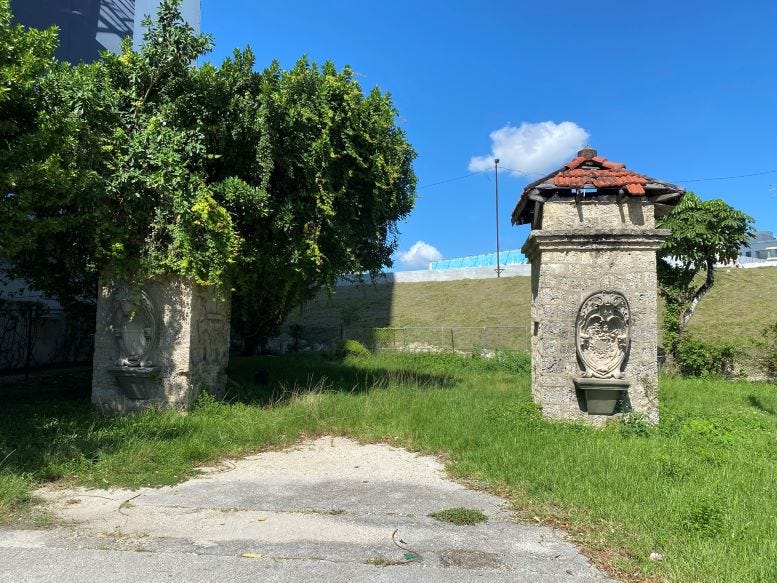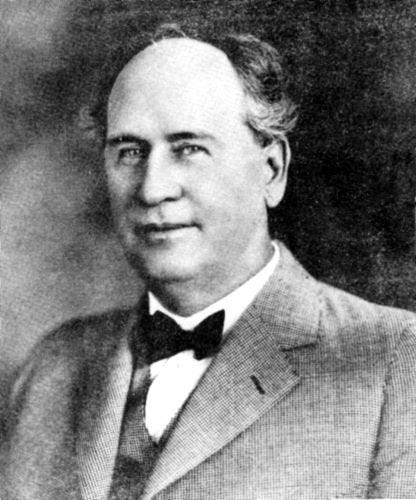Gate Columns of Halissee Hall
A remnant of a foregone era, the gate posts of the Halissee Hall entrance on NW 10th Avenue, near the Jackson Health Complex, still stand to remind us of Miami's early years.
Located near downtown Miami along NW 10th Avenue, nestled between the 836-expressway and a modern office building which is host to Atlantic University, stands what appears to be ruins from a bygone era. Two gate posts that seem to have been misplaced not only from the rest of its original fortification, but also from its time period. These columns once provided the anchor for the entrance to one of the most prominent residences, constructed during the City of Miami’s formative years by one of the city’s illustrious founding pioneers, John Sewell.
When Sewell embarked on constructing his home, on what was considered the outskirts of town when it was built in 1912, he insisted on leveraging native resources to construct his estate. At the time, Dade County pine trees and oolitic limestone were plentiful in South Florida and were felled and quarried to provide building material for many of the early structures constructed in Miami.
Just as Sewell had envisioned a grand design for his residence, he also crafted a plan for an elaborate entrance to his estate, which was constructed at the terminus of a long winding road more than a quarter of a mile from the front door of his residence. What is left of that grand entrance are the two gate columns found along today’s NW 10th Avenue.
Who Was John Sewell?
When Henry Flagler agreed to construct a luxurious hotel and help layout a city in what would become Miami, he turned to 29-year-old John Sewell to get the project started. When he and his brother, Everest G. Sewell, arrived along the shores of the Miami River in March of 1896, they were joined by a group of twelve black workman who John referred to as his ‘Black Artillery.’ Sewell supervised his crew to clear the land for the street layout and Flagler’s luxurious Royal Palm hotel.
One of the reasons Sewell referred to his works as an ‘artillery’ was that he could point them at any challenging task, and they would get the job done. The undertaking of clearing the land was difficult, but between his crew of workers, and the occasional use of dynamite for the more persistent foliage, Sewell was able to get what was expected of him and his crew done effectively and on time.
When it came time to vote on incorporation, Sewell once again marshalled his black artillery, at this point numbering more than one hundred workman, to cast their ballot to organize as a city so that the municipality would not have to first incorporate as town. The State of Florida required at least three hundred votes to organize a municipality as a city. Without Sewell’s workers casting their vote, Miami would not have reached the minimum number of voters to incorporate as a city.
In 1899, Sewell petitioned city officials for $3,000 of their budget for street construction so that his workers would stay employed and in town to cast their vote to determine the location of the Dade County seat. Once again, the vote cast by Sewell’s workers ensured that the Magic City won the right to become the county seat over West Palm Beach, ensuring that the location of Dade County operations would shift from Juno to Miami. The black labor force who worked for the Florida East Coast organization, and reported to John Sewell, were instrumental in the development and evolution of Miami during the city’s formative years.
In addition to his role as a supervisor and representative for the Florida East Coast company, Sewell and his brother, Everest, started one of the first retail establishments in Miami and conducted business on Flagler Street for decades selling men’s clothing and shoes as Sewell Brothers store. John was elected as the third mayor of Miami and would serve the city in that role from 1903 to 1907. As the city grew, so did John’s profile and wealth. By 1912, he was determined to construct a residence which reflected his affluence.
Keep reading with a 7-day free trial
Subscribe to Miami History to keep reading this post and get 7 days of free access to the full post archives.






